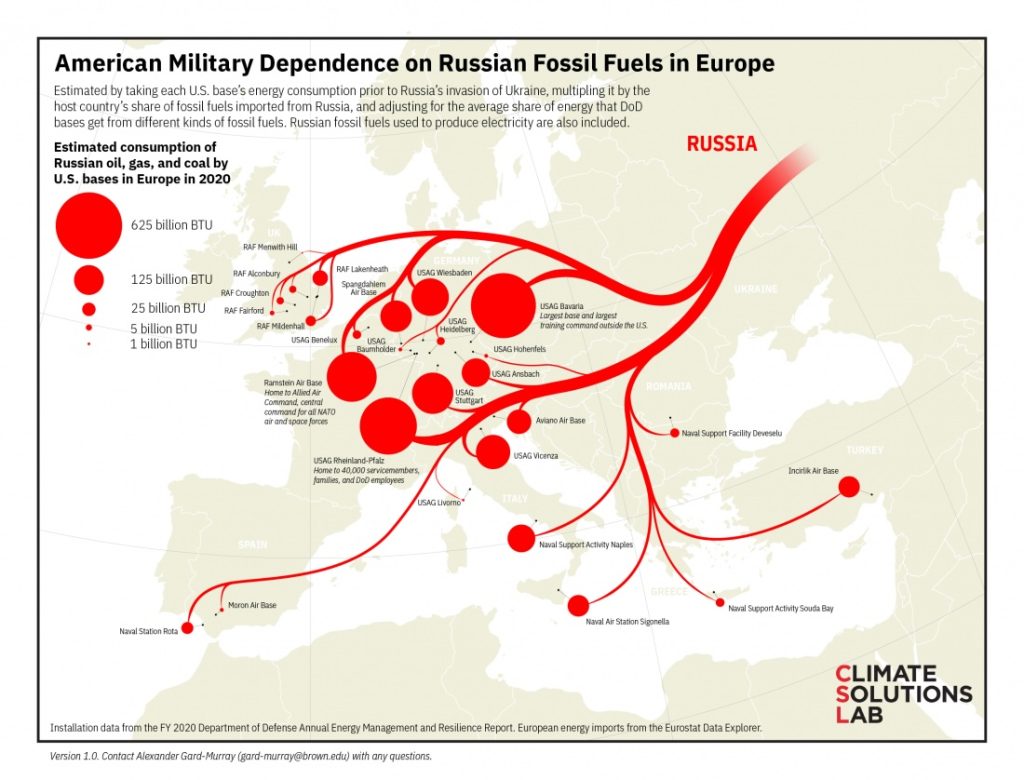Nearly four months after the deadline, the Defense Department has not fulfilled a congressional mandate to submit a plan for weaning U.S. military bases in Europe off of Russian energy. That reliance could “be helping to fund the Russian war effort to the tune of a million dollars a week,” Brown University researchers wrote in a 2022 analysis.
The Fiscal Year 2023 National Defense Authorization Act called the issue “a critical challenge for national security activities” and directed the department to make plans to reduce and eventually eliminate reliance on Russian energy for each base across Europe. Specifically, the bill called for a description of steps that each base in Europe could take, including investments in technology, infrastructure and renewable energy, to be submitted no later than 12 months after the bill was enacted on Dec. 23, 2022. The goal was to eliminate use of Russian energy within five years of each base writing its plan—but progress has stalled.
“Our bases are still running on Russian gas, which I just find mind-blowing that we have to talk about this and, frankly, that Congress is having to push the department on this,” Rep. Mike Waltz (R-Fla.), Chairman of the Subcommittee on Readiness, said at a hearing April 16. “One would think that this would be something that the department would be pushing itself on.”

At the hearing, Waltz presented a map published by Brown University’s Climate Solutions Lab that charts the estimated flow of Russian oil, gas, and coal to U.S. bases across Europe in 2020. Researchers estimated that before Russia’s full-scale invasion of Ukraine started in 2022, U.S. bases in Europe relied on Russian fossil fuels to meet 30 percent of their annual energy needs, which translates to about half a million barrels of oil from Russia every year.
That supply “represents a serious threat” to security, the Lab wrote, since Russia has the option to cut off a major source of energy. But it also “fuels Russia’s war machine,” Waltz said.
Waltz is not the only one concerned: despite a ban on Russian oil products, the European Union continues to buy millions of barrels of refined fuels originating at least in part in Russia, according to Politico. Loopholes allow countries to buy the banned Russian crude as long as it is refined into fuel somewhere else, such as India or Turkey. In November, the Washington Post investigated how the loopholes affect U.S. military supply chains, finding that the Pentagon paid nearly $1 billion in contracts since March 2022 to a Greek refinery that receives crude from Turkey, a step which obscures the crude’s origins in Russia.
“The fact that those shipments contained material that originated in Russia underscores the porousness of the sanctions and the failure to aggressively enforce them,” the Post reported.
When Waltz asked for the status of energy plans, Brendan Owens, the assistant secretary of defense for energy, installations and environment, said the topic was at the front of mind of installation commanders during a recent trip through Europe.
“This was a significant point of conversation everywhere we went,” he said. “They are posturing themselves to bring the energy resources that they need increasingly closer to the fence line.”
However, Owens did not have a timeline for the delivery of the plan, saying that it was still “under development.” Waltz pressed him to submit a timeline this week.
“Can you imagine if I took this to one of my town halls?” the chairman asked, referring to the map. “Right now, as we’re talking about billions and billions going to Ukraine … and their [taxpayers’] money is basically fueling the other side of the war through our bases and, oh by the way, making our service members vulnerable.”
Waltz’ critique comes as the Air Force and the Pentagon writ large seeks to shore up the vulnerability of its energy infrastructure to enemy attack and to climate change. Dr. Ravi Chaudhary, assistant secretary of the Air Force for energy, installations and environment, said bases are looking to use microgrids to sustain their own power through on-base sources such as solar panels, wind turbines, biomass, nuclear microreactors, and/or fossil-fuel powered generators. The idea is that if one source fails, the system overall can keep chugging.
“By building redundancy into your installation in terms of power and energy … it’s like putting a power bar into your room because now you can plug in power sources that you want,” Chaudhary said in March.
Implementing a similar mindset could help in Europe, Waltz said.
“You get two for one,” he said. “You’re off of gas, you’re off of oil and you get an operational resiliency—and gee—you start impacting Putin’s war machine, for which we’re asking the American people to keep digging deeper into their pockets to combat against.”
